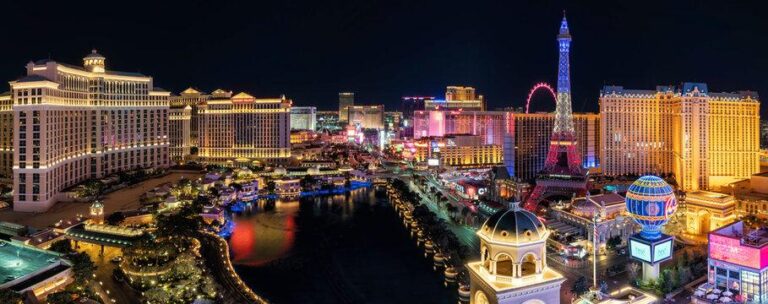Las Vegas at a Crossroads: Navigating Environmental, Social, and Economic Challenges
Environmental Pressures Amidst the City of Lights
Renowned worldwide for its vibrant nightlife and entertainment extravaganzas, Las Vegas now faces escalating environmental challenges that threaten its sustainability. The city’s extravagant lifestyle-with its expansive casinos, opulent resorts, and water-intensive recreational facilities-places immense strain on the fragile desert ecosystem. Central to this crisis is Lake Mead, the primary water reservoir for Las Vegas and surrounding regions, which has experienced historic declines due to prolonged drought and excessive consumption.This alarming trend has pushed local authorities to consider stringent water conservation measures that could fundamentally alter the city’s operations.
Environmental specialists highlight a self-perpetuating cycle of resource depletion fueled by relentless urban expansion and tourism demand. Critical contributors to this strain include:
- Excessive water consumption: Over 90% of the city’s water is sourced from the Colorado River, which is currently facing unprecedented shortages.
- Urban heat amplification: The extensive use of concrete and bright neon lighting intensifies local temperatures, increasing energy and water needs.
- Waste accumulation: The volume of solid waste generated surpasses the desert’s natural capacity to manage it,leading to environmental degradation.
| Resource | Annual Usage | Environmental Consequences |
|---|---|---|
| Water | Approximately 220 billion gallons | Severe depletion of Lake Mead and groundwater stress |
| Electricity | Over 13 million MWh | Elevated carbon emissions and intensified urban heat |
| Waste | Nearly 1.6 million tons | Landfill overcapacity and disruption of local habitats |
Las Vegas’s challenge lies in balancing its luxurious image with ecological realities, making it a pivotal example of sustainability struggles in arid urban centers. The pressing question remains: can the city innovate to preserve its allure without exhausting its natural resources?
Tourism’s Toll on Community Well-being and Infrastructure
The continuous influx of visitors, while economically vital, has placed notable pressure on Las Vegas’s local communities and infrastructure. The booming tourism industry has inadvertently intensified housing shortages and strained public services, exacerbating social inequalities.Longtime residents are increasingly displaced by rising rents and gentrification, often relocating to peripheral neighborhoods with fewer amenities. Simultaneously occurring, community spaces and cultural institutions struggle to compete with the dominance of casino resorts and luxury developments that cater primarily to tourists.
Infrastructure systems are similarly overwhelmed. Roads, public transit, and utilities frequently operate beyond their designed capacities, resulting in service disruptions and inefficiencies. Despite ongoing investments in infrastructure expansion, persistent issues such as traffic congestion, water shortages, and waste disposal challenges remain prevalent. The following table summarizes key infrastructure stress points linked to the city’s tourism-driven growth:
| Infrastructure Component | Primary Challenge | Consequences |
|---|---|---|
| Road Networks | Persistent congestion | Longer commutes and increased air pollution |
| Water Systems | Overexploitation amid drought | Mandatory water restrictions for residents and resorts |
| Waste Management | Escalating landfill volumes | Environmental contamination risks and rising costs |
- Local enterprises face difficulties retaining staff due to soaring living expenses.
- Community advocates demand more lasting tourism practices and equitable urban planning.
- Municipal leaders are under increasing pressure to harmonize economic gains with residents’ quality of life.
Confronting Housing Affordability and Urban Expansion
Las Vegas is grappling with a complex housing crisis fueled by rapid population growth and limited affordable options. The city’s notorious urban sprawl has outpaced the advancement of essential infrastructure and public services, creating pockets of unaffordable housing and social fragmentation.As demand surges, many low- and middle-income families are pushed to the city’s outskirts or forced into inadequate living conditions, raising serious social and economic concerns.
Major obstacles include:
- Escalating construction expenses that hinder affordable housing projects.
- Zoning regulations and building codes that restrict higher-density developments.
- Insufficient public transit investments connecting outlying neighborhoods to urban centers.
Without targeted policy interventions-such as inclusive zoning reforms and incentives for affordable housing-Las Vegas risks deepening socioeconomic disparities. Urban planners and developers must strive to create sustainable, inclusive communities that accommodate diverse income groups while managing growth responsibly.
Pathways to Sustainable Development and Improved Livability
For Las Vegas to thrive sustainably,a strategic pivot is essential-one that diversifies the economy and centers on enhancing residents’ quality of life. City officials and stakeholders are championing initiatives that promote technology innovation,renewable energy adoption,and educational advancement to prepare a resilient workforce. These efforts aim to reduce the city’s heavy reliance on tourism and foster stable, well-paying employment opportunities.
Improving livability also requires addressing critical infrastructure and social service gaps. Priority areas include:
- Affordable housing: Increasing availability of safe, reasonably priced homes for all demographics.
- Public transit: Expanding efficient,environmentally kind transportation options to alleviate congestion and pollution.
- Health and wellness programs: Enhancing access to preventive care and mental health resources to support community well-being.
| Sector | Current Emphasis | Future Opportunities |
|---|---|---|
| Tourism | Entertainment and gaming | Eco-tourism and cultural heritage experiences |
| Technology | Startup incubators and innovation centers | Green technology and sustainable energy solutions |
| Housing | Market-driven developments | Affordable, eco-friendly community projects |
Conclusion: The Future of Las Vegas Hinges on Adaptation
Las Vegas stands at a pivotal juncture, confronting multifaceted challenges that threaten its identity and long-term viability. From environmental constraints to social inequities and economic dependencies, the city’s future will depend on innovative policies and collaborative leadership. As Las Vegas seeks to redefine itself beyond the neon glow,its journey will serve as a critical case study in urban resilience and sustainable conversion.




